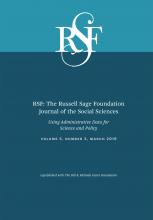Research Article
Open Access
The American Opportunity Study: A New Infrastructure for Monitoring Outcomes, Evaluating Policy, and Advancing Basic Science
David B. Grusky, Michael Hout, Timothy M. Smeeding, C. Matthew Snipp
RSF: The Russell Sage Foundation Journal of the Social Sciences March 2019, 5 (2) 20-39; DOI: https://doi.org/10.7758/RSF.2019.5.2.02
David B. Grusky
aBarbara Kimball Browning Professor in the School of Humanities and Sciences at Stanford University
Michael Hout
bProfessor of sociology at New York University
Timothy M. Smeeding
cLee Rainwater Distinguished Professor of Public Affairs and Economics at the La Follette School of Public Affairs, University of Wisconsin–Madison
C. Matthew Snipp
dBurnet C. and Mildred Finley Wohlford Professor of Humanities and Sciences in the Department of Sociology at Stanford University

REFERENCES
- ↵
- Aaronson, Daniel, and
- Bhashkar Mazumder
- ↵
- Aizer, Anna, and
- Janet V. Currie
- ↵
- Aizer, Anna,
- Shari Eli,
- Joseph Ferrie, and
- Adriana Lleras-Mune
- ↵
- ↵
- Almond, Douglas,
- Janet Currie, and
- Valerie Duque
- ↵
- Almond, Douglas,
- Hilary W. Hoynes, and
- Diane W. Schanzenbach
- ↵
- ↵
- Ananat, Elizabeth O.,
- Anna Gassman-Pines,
- Dania V. Francis, and
- Christina M. Gibson-Davis
- ↵
- Autor, David H.,
- Mark Duggan,
- Kyle Greenberg, and
- David S. Lyle
- ↵
- Barker, David
- ↵
- Berlin, Gordon
- ↵
- Blau, Peter M., and
- Otis Dudley Duncan
- ↵
- Bollinger, Christopher,
- Barry T. Hirsch,
- Charles Hokayem, and
- James P. Ziliak
- ↵
- ↵
- Brown, David W.,
- Amanda E. Kowalski, and
- Ithai Z. Lurie
- ↵
- Cancian, Maria,
- Carolyn J. Heinrich, and
- Yiyoon Chung
- ↵
- Cascio, Elizabeth U., and
- Diane Whitmore Schanzenbach
- ↵
- Chetty, Raj
- ↵
- Chetty, Raj,
- John N. Friedman,
- Nathaniel Hilger,
- Emmanuel Saez,
- Diane Whitmore Schanzenbach, and
- Danny Yagan
- ↵
- ↵
- Chetty, Raj,
- Nathaniel Hendren, and
- Lawrence F. Katz
- ↵
- Chetty, Raj,
- Nathaniel Hendren,
- Patrick Kline,
- Emmanuel Saez, and
- Nicholas Turner
- ↵
- Commission on Evidence-Based Policymaking (CEP
- ↵
- Council of Economic Advisers
- ↵
- Cunha, Flavio, and
- James J. Heckman
- ↵
- ↵
- Decker, Paul T
- ↵
- ↵
- ↵
- ↵
- Evans, William N., and
- Craig L. Garthwaite
- ↵
- Featherman, David L., and
- Robert M. Hauser
- ↵
- Figlio, David,
- Jonathan Guryan,
- Krzysztof Karbownik, and
- Jeffrey Roth
- ↵
- Fischer, Claude S., and
- Michael Hout
- ↵
- Furman, Jason
- ↵
- ↵
- ↵
- Hart, Nick, and
- Sandy Davis
- ↵
- Haskins, Ron, and
- Greg Margolis
- ↵
- ↵
- ↵
- ↵
- Hout, Michael
- ↵
- ↵
- Hoynes, Hilary,
- Diane Whitmore Schanzenbach, and
- Douglas Almond
- ↵
- Jacob, Brian,
- Susan Dynarski,
- Kenneth Frank, and
- Barbara Schneider
- ↵
- ↵
- Kille, Leighton Walter
- ↵
- ↵
- Lee, Keun Bok,
- David J. Harding, and
- Jeffrey D. Morenoff
- ↵
- Looney, Adam, and
- Nicholas Turner
- ↵
- Manza, Jeff, and
- Clem Brooks
- Massey, Catherine G., and
- Amy O’Hara
- Mazumder, Bhashkar
- ↵
- Mervis, Jeffrey
- ↵
- ↵
- ↵
- ↵
- Mitnik, Pablo A.,
- Victoria Bryant,
- David B. Grusky, and
- Michael Weber
- ↵
- National Academies of Sciences, Engineering, and Medicine (NASEM)
- ↵
- National Research Council (NRC)
- ↵
- National Research Council (NRC)
- ↵
- Noyes, Jennifer
- ↵
- Office of the Mayor
- ↵
- Price, David J., and
- Jae Song
- ↵
- Reamer, Andrew, and
- Julia Lane
- ↵
- Shaefer, H. Luke,
- Sophie Collier,
- Greg Duncan.
- Kathryn Edin,
- Irwin Garfinkel,
- David Harris,
- Timothy M. Smeeding,
- Jane Waldfogel,
- Christopher Wimer, and
- Hiro Yoshikawa
- ↵
- Smeeding, Timothy M., and
- Katherine A. Thornton
- ↵
- Stevens, Ann,
- Michal Kurlaender, and
- Michel Grosz
- ↵
- Tam, Siu-Ming, and
- Frederic Clarke
- ↵
- Trépanier, Julie,
- Jean Pignal, and
- Don Royce
- ↵
- ↵
- ↵
- Weeden, Kim A., and
- David B. Grusky
- ↵
- Wherry, Laura R.,
- Sarah Miller,
- Robert Kaestner, and
- Bruce D. Meyer
- ↵
- Wimer, Christopher,
- Marybeth Mattingly,
- Sara Kimberlin,
- Jonathan Fisher,
- Caroline Danielson, and
- Sarah Bohn
- ↵
- Wimer, Christopher,
- Marybeth Mattingly,
- Matt Levin,
- Caroline Danielson, and
- Sarah Bohn
- ↵
- Wimer, Christopher,
- Marybeth Mattingly,
- Matt Levin,
- Caroline Danielson, and
- Sarah Bohn
- ↵
- Yiu, Chris
In this issue
The American Opportunity Study: A New Infrastructure for Monitoring Outcomes, Evaluating Policy, and Advancing Basic Science
David B. Grusky, Michael Hout, Timothy M. Smeeding, C. Matthew Snipp
RSF: The Russell Sage Foundation Journal of the Social Sciences Mar 2019, 5 (2) 20-39; DOI: 10.7758/RSF.2019.5.2.02
The American Opportunity Study: A New Infrastructure for Monitoring Outcomes, Evaluating Policy, and Advancing Basic Science
David B. Grusky, Michael Hout, Timothy M. Smeeding, C. Matthew Snipp
RSF: The Russell Sage Foundation Journal of the Social Sciences Mar 2019, 5 (2) 20-39; DOI: 10.7758/RSF.2019.5.2.02
Jump to section
- Article
- Abstract
- THE PAYOFF TO ANALYZING PROGRAMS AND POLICIES WITH BIG PUBLIC DATA
- A SHORT HISTORY OF THE AMERICAN OPPORTUNITY STUDY
- THE STRUCTURE OF THE AMERICAN OPPORTUNITY STUDY
- BENEFITS OF THE AMERICAN OPPORTUNITY STUDY
- THE AMERICAN OPPORTUNITY STUDY AND THE COMMISSION ON EVIDENCE-BASED Policymaking
- CONCLUSION
- FOOTNOTES
- REFERENCES
- Figures & Data
- Info & Metrics
- References
Related Articles
- No related articles found.
Cited By...
- No citing articles found.





